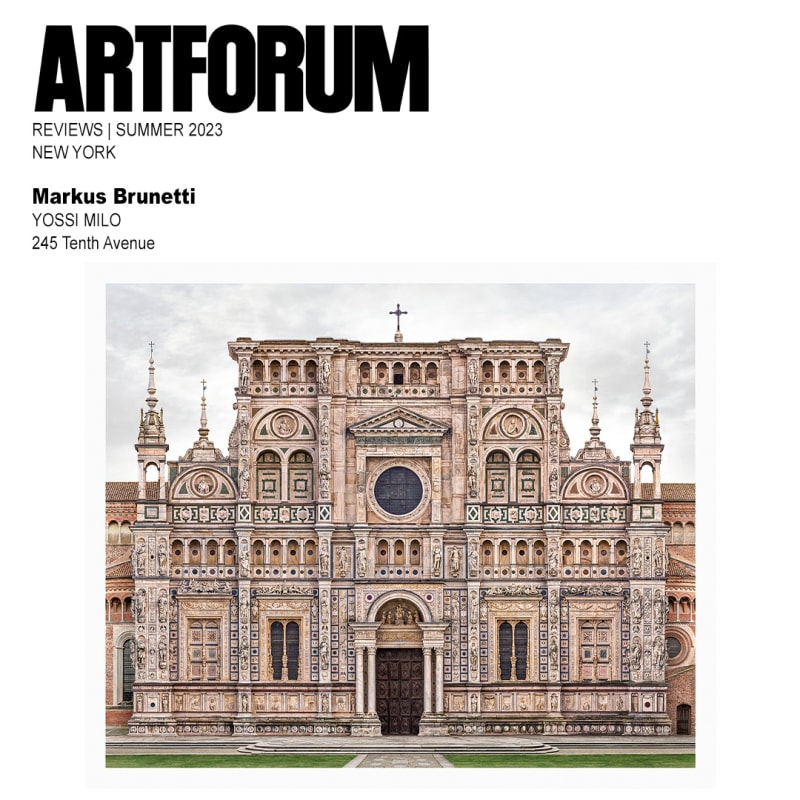Markus Brunetti's photographs depict the facades of Europe's sacred architecture-synagogues, monasteries, and cathedrals-all of which have managed to live through, to paraphrase James Joyce, the nightmare of history. Brunetti's images breathe fresh life into these majestic edifices of the past: Just as decades of devotion were needed to build these stately wonders, Brunetti had to put in years and years of devotion to make his photographic masterpieces. His work is informed by the persistence, patience, diligence, and dedication of the ingenious architects who designed these heavenly buildings-and of the craftspeople who constructed them-to last forever. Philosopher William Ernest Hocking argued that religion was the cradle of art; Brunetti's works argue that art is the cradle of religion.
Brunetti takes thousands of photographs of his subjects, which he then digitally edits, layers, and arranges to form composite images. The process is an obsessive form of construction that emulates the efforts of the laborers who meticulously built these godly structures, brick by brick. (The artist lives in a fire truck that he converted into a photo lab; he uses the vehicle to travel from one sacred structure to another.) There is a manic compulsiveness to Brunetti's pursuit, as though he is afraid that time will somehow catch up to these timeless places. The artist has gone all over Europe to find his subjects-venerable pearls in a profane world, holding their eternal own in everyday society. If curiosity is the saving grace of consciousness, then his cognizance of this type of architecture suggests that he could be on a mission to save his soul, for devoting his life to photographing reverent sites is, to my mind, an act of worship. He's like a pilgrim visiting holy sites in search of a blessing-or even a miracle.
Cambridge, King's College Chapel, 2014-23, Brunetti's lovingly rendered picture of the eponymous building, an example of late perpendicular gothic architecture designed by master mason Reginald Ely, is almost surreal in its pristine exactitude. (England's King Henry VI was only nineteen when he laid the first stone for the structure in 1441; it was completed in 1515.) Its pair of front-facing towers rise high into the dull-gray sky, like outstretched arms in holy surrender. The massive stained-glass windows in the facade call to mind a wide-open mouth-perhaps one that belongs to an unhappy God, ready to devour his unruly, disobedient creations. While Brunetti's picture of the chapel is indeed imposing, it is not cold. His careful manipulations of the image do not deaden it, but bring it vividly to life, as if the spirit of the place itself were somehow captured by the artist and stored inside it. So many of Brunetti's works, such as Sigüenza, Catedral Santa Maria, 2018-23, and Cordoba, Mezquita-Catedral, 2013-23 (the latter depicting a former mosque that became the Cathedral of Our Lady of the Assumption during the fourteenth century), possess an uncanny kind of sentience. These prints go well beyond two dimensions-they act upon the viewer in surprising and subtle ways.
All of the artist's works are "good" to the extent that they are formally and aesthetically convincing. His preservationist instinct is a tribute to the living remains of "old" art in its most majestic forms. They also signal the revival of interest in traditional art, as these religious structures are astonishingly grand examples of it-antitheses of the shopworn ironies and solipsism of contemporary culture, or of what historian Suzi Gablik characterized as the failure of modern art to save us from ourselves. Gablik called for "a return of soul," and to a great degree that is true of Brunetti's compelling portraits of sacred facades. Indeed, he suggests that soulfulness has never left us, provided you know where to look. Much as artists in the classical past have turned to the ruins of antiquity for inspiration, Brunetti approaches these buildings for a similar sense of awe and wonderment.
-Donald Kuspit

